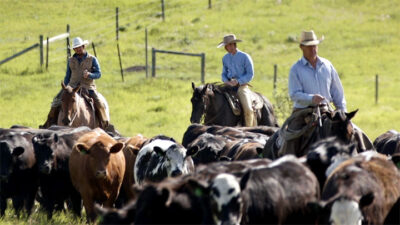‘Guardians of the Grasslands’ highlights importance of saving endangered native prairie landscape
By Tim Kalinowski on May 7, 2021.
 Submitted photo -
Riders move a herd of cattle in a scene from the documentary 'Guardians of the Grasslands' on the importance of preserving Canada's few remaining native prairie grasslands for future generations.
Submitted photo -
Riders move a herd of cattle in a scene from the documentary 'Guardians of the Grasslands' on the importance of preserving Canada's few remaining native prairie grasslands for future generations.LETHBRIDGE HERALDtkalinowski@lethbridgeherald.com
Ducks Unlimited Canada, the Canadian Cattlemen Association, and the Nature Conservancy of Canada are teaming up to make their 2019 documentary short film “Guardians of the Grasslands” even more accessible to the public by now streaming it on YouTube and other social media platforms.
Filmed on location at the Waldron Ranch Grazing Co-op near Longview in the Porcupine Hills, the film speaks to the importance of preserving Canada’s few remaining native prairie grasslands, considered to be among the most endangered ecological landscapes in the world, for future generations. It also represents a call to action to do more to conserve this important ecological resource, says one of the film’s featured presenters, Ben Campbell.
“I think we need to save the grasslands,” he says. “This isn’t a way to sell more beef for me. This isn’t a way to increase my reputation. This actually matters to me. I actually care about the grasslands, and species that depend on the grasslands. We have a saying in the (agriculture) community that you return something better than you borrow it. So if you borrow someone’s truck, you return it with a full tank of gas. We are borrowing this planet from our grandchildren; so we are trying constantly to make it better than when we got it.”
The film also speaks to the important roles ranchers and cattle grazing have in preserving these endangered landscapes.
“Part of it is also dispelling myths,” acknowledges Campbell. “In Canadian grasslands it is not like we are cutting down the Amazon rainforest to have cattle. We are grazing cattle naturally on a native range that requires large herds of ruminants (grazing animals). Cattle are actually now a keystone species, and they are beneficial.”
As a rancher himself who rents part of his own pasture from another landowner, Campbell is all too familiar with the economic pressures put on native grasslands in Alberta.
“I have rented pasture, and my landlord has gotten phone calls from a grain farmer,” Campbell explains “They actually want to come in, spray (the native grass) down, and rip it up. And it is up to me to find a way to economically compete with that grain farmer to use it for cattle and keep it in grass.
“Ripping up the grasslands is akin to burning up the Mona Lisa or burning a library full of original manuscripts,” he states. “What’s the value of the Mona Lisa? It’s a one of a kind thing that you will never get back.”
Campbell points out that 86 per cent of the animals that rely on grasslands have disappeared since 1970, paralleling the demise of the grasslands themselves. Only about 20 per cent of the grasslands which once dominated Western Canada remain still relatively untouched by human enterprise. Campbell wonders when Albertans will wake up to this fact?
“We need to take really solid and firm action or else it will be gone,” he says. “And it doesn’t come back. It’s incredibly valuable, and it is hard for me to understand why some people don’t value it.
“I really hope the film advances knowledge and understanding of the problem that’s right in front of us, as well as knowledge of this beautiful gem we have in front of us which is the Canadian grasslands,” Campbell adds. “If we can get people to understand what we have, and the value it has, and the urgency that we have to do something to protect and save it, that would be huge.
To view “Guardians of the Grasslands” see it on YouTube at http://www.youtube.com/watch?v=_CG4ROvCu0Y.
To learn more about the film, and efforts being made to preserve the remaining native prairie grasslands, visit guardiansofthegrasslands.ca.
Follow @TimKalHerald on Twitter
Follow @@TimKalHerald on Twitter
4-3


